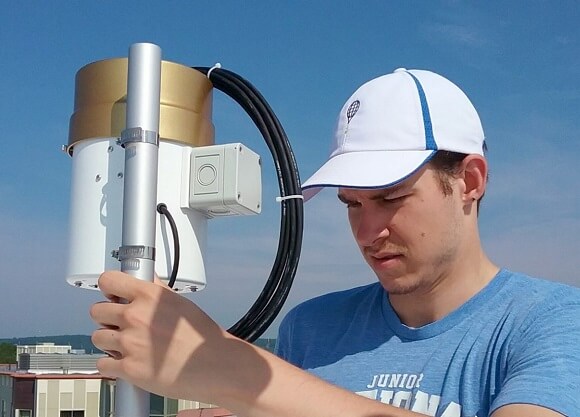
University to monitor eclipse in real time August 21, 2017
August 21, 2017

August 21, 2017

“It’s such a rare and awe-inspiring celestial event,” explained Professor Kimberly DiGiovanni, assistant teaching professor of civil engineering. “I’ve never seen one and am pretty excited. My sister, aunt and uncle are traveling south by rail to view this one in totality.”
DiGiovanni will be in one of our School of Engineering labs monitoring data captured by weather stations on our Mount Carmel and York Hill campuses. The 2-foot by 2-foot devices mounted about 6 feet above a couple of our residence halls collect solar radiation, air temperature, relative humidity, wind speed and direction, barometric pressure, and rain and snow amounts.
Melkis Espinal ’16, a software engineering major, developed a website to display the data collected in real-time from the weather station as part of his capstone project last year under the guidance of Software Engineering Professor Stefan Christov.
“What he has done is pretty cutting-edge,” DiGiovanni said. “It’s not an easy task to build a website and a data management system like what he has launched and laid the framework for future development.”
It is vitally important that engineers understand the weather, she said.
“Considering the weather in engineering is increasingly challenging as we face global climate change and experience shifting weather patterns,” DiGiovanni warned. “For example, the Northeast is projected to receive more intense rainfall events and warmer temperatures. Engineers work with city planners and others to develop climate change mitigation and adaptation strategies.”
Our weather station is relatively unique; most engineering programs lack access to data collected so close and both accessible and achievable in real time.
“Civil engineering students use the data from the weather stations in their required hydrology/hydraulics course,” DiGiovanni said. “They analyze data from campus weather stations to calculate rainfall intensities and cumulative rainfall depth. They use these parameters for estimating runoff volumes for specific storm events and design infrastructure to manage the anticipated runoff.”
In terms of today’s eclipse, DiGiovanni has finalized her forecast of what we should expect.
“We anticipate that as the moon crosses and blocks the sun, the value of the solar radiation readings will decrease,” she said. “Vice-versa, after the peak, we’ll expect to see the value increase as the sun is uncovered.”
The partial eclipse is expected to begin at 1:25 p.m. over our campuses, reaching its climax at 2:45 and ending at 4 p.m. Please do not look at the eclipse without special protective eyeware designed for the event.
We will share DiGiovanni’s findings later today on Facebook.
Quinnipiac Today is your source for what's happening throughout #BobcatNation. Sign up for our weekly email newsletter to be among the first to know about news, events and members of our Bobcat family who are making a positive difference in our world.
Sign Up Now